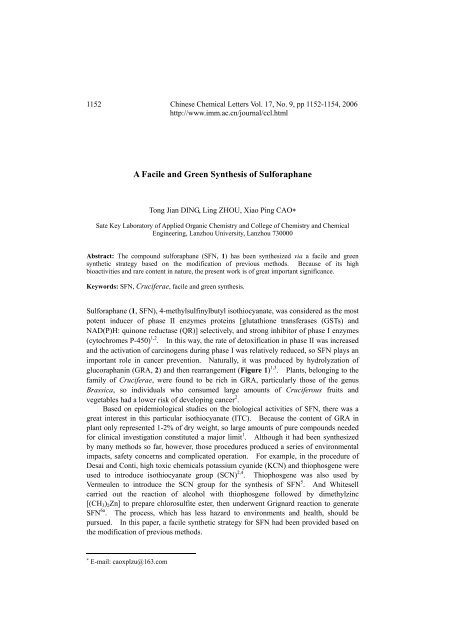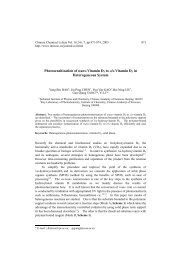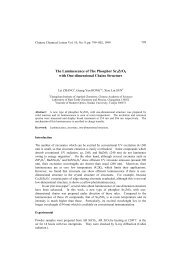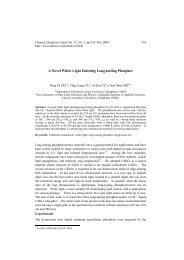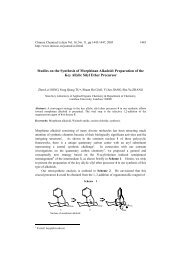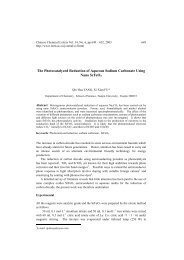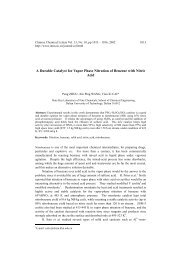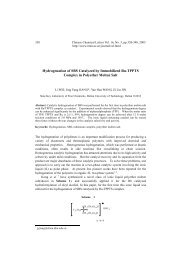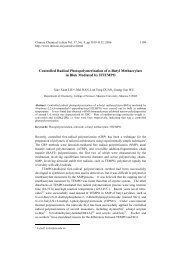A Facile and Green Synthesis of Sulforaphane
A Facile and Green Synthesis of Sulforaphane
A Facile and Green Synthesis of Sulforaphane
You also want an ePaper? Increase the reach of your titles
YUMPU automatically turns print PDFs into web optimized ePapers that Google loves.
1152<br />
Chinese Chemical Letters Vol. 17, No. 9, pp 1152-1154, 2006<br />
http://www.imm.ac.cn/journal/ccl.html<br />
A <strong>Facile</strong> <strong>and</strong> <strong>Green</strong> <strong>Synthesis</strong> <strong>of</strong> <strong>Sulforaphane</strong><br />
Tong Jian DING, Ling ZHOU, Xiao Ping CAO∗<br />
Sate Key Laboratory <strong>of</strong> Applied Organic Chemistry <strong>and</strong> College <strong>of</strong> Chemistry <strong>and</strong> Chemical<br />
Engineering, Lanzhou University, Lanzhou 730000<br />
Abstract: The compound sulforaphane (SFN, 1) has been synthesized via a facile <strong>and</strong> green<br />
synthetic strategy based on the modification <strong>of</strong> previous methods. Because <strong>of</strong> its high<br />
bioactivities <strong>and</strong> rare content in nature, the present work is <strong>of</strong> great important significance.<br />
Keywords: SFN, Cruciferae, facile <strong>and</strong> green synthesis.<br />
<strong>Sulforaphane</strong> (1, SFN), 4-methylsulfinylbutyl isothiocyanate, was considered as the most<br />
potent inducer <strong>of</strong> phase II enzymes proteins [glutathione transferases (GSTs) <strong>and</strong><br />
NAD(P)H: quinone reductase (QR)] selectively, <strong>and</strong> strong inhibitor <strong>of</strong> phase I enzymes<br />
(cytochromes P-450) 1,2 . In this way, the rate <strong>of</strong> detoxification in phase II was increased<br />
<strong>and</strong> the activation <strong>of</strong> carcinogens during phase I was relatively reduced, so SFN plays an<br />
important role in cancer prevention. Naturally, it was produced by hydrolyzation <strong>of</strong><br />
glucoraphanin (GRA, 2) <strong>and</strong> then rearrangement (Figure 1) 1,3 . Plants, belonging to the<br />
family <strong>of</strong> Cruciferae, were found to be rich in GRA, particularly those <strong>of</strong> the genus<br />
Brassica, so individuals who consumed large amounts <strong>of</strong> Cruciferous fruits <strong>and</strong><br />
vegetables had a lower risk <strong>of</strong> developing cancer 2 .<br />
Based on epidemiological studies on the biological activities <strong>of</strong> SFN, there was a<br />
great interest in this particular isothiocyanate (ITC). Because the content <strong>of</strong> GRA in<br />
plant only represented 1-2% <strong>of</strong> dry weight, so large amounts <strong>of</strong> pure compounds needed<br />
for clinical investigation constituted a major limit 1 . Although it had been synthesized<br />
by many methods so far, however, those procedures produced a series <strong>of</strong> environmental<br />
impacts, safety concerns <strong>and</strong> complicated operation. For example, in the procedure <strong>of</strong><br />
Desai <strong>and</strong> Conti, high toxic chemicals potassium cyanide (KCN) <strong>and</strong> thiophosgene were<br />
used to introduce isothiocyanate group (SCN) 2,4 . Thiophosgene was also used by<br />
Vermeulen to introduce the SCN group for the synthesis <strong>of</strong> SFN 5 . And Whitesell<br />
carried out the reaction <strong>of</strong> alcohol with thiophosgene followed by dimethylzinc<br />
[(CH3)2Zn] to prepare chlorosulfite ester, then underwent Grignard reaction to generate<br />
SFN 6a . The process, which has less hazard to environments <strong>and</strong> health, should be<br />
pursued. In this paper, a facile synthetic strategy for SFN had been provided based on<br />
the modification <strong>of</strong> previous methods.<br />
∗ E-mail: caoxplzu@163.com
HO HO<br />
HO<br />
HO<br />
Tong Jian DING et al. 1153<br />
Figure 1 SFN enzymatically hydrolysed from GRA<br />
O<br />
OH<br />
-O3SO 2<br />
myrosinase<br />
rearrangement<br />
1<br />
N<br />
S<br />
O<br />
S<br />
S<br />
C<br />
N<br />
Scheme 1 <strong>Synthesis</strong> <strong>of</strong> SFN<br />
OH<br />
a Br<br />
OH<br />
b N3 3 4 5<br />
N3 OTs<br />
d<br />
N3 S e S<br />
C<br />
N<br />
S<br />
f<br />
1<br />
6 7 8<br />
Reagents: a. HBr (40%), benzene, 53% yield; b. NaN3, DMF, 61% yield; c. TsCl, Py, CH2Cl2, 95%<br />
yield; d. MeSNa, DMF; e. PPh3, ether, then CS2; f. oxone, CH2Cl2, 80% yield (from 6 to 1).<br />
As shown in Scheme 1, a mixture <strong>of</strong> 1,4-butanediol 3 <strong>and</strong> aqueous hydrobromic<br />
acid (HBr, 40%) in benzene was refluxed for 20 hs, removing the water at the same time,<br />
to afford monobromoalkanol 4 as an oil in 53% yield purified by Kugelrohr distillation 7 .<br />
Then alcohol 4 was reacted with sodium azide (NaN3) at 70°C for 24 hs in dry<br />
N,N-dimethylformamide (DMF) to afford 4-azido-1-butanol 5 as an oil in 61% yield 8 .<br />
Treatment <strong>of</strong> 5 with p-toluenesulfonyl chloride (TsCl) in the presence <strong>of</strong> pyridine in<br />
dichloromethane (CH2Cl2) gave the protected alcohol 6 as an oil in 95% yield. Then a<br />
solution <strong>of</strong> compound 6 in DMF was added into the mixture <strong>of</strong> NaSMe in dry DMF<br />
under argon atmosphere at 0°C, the SN2 type reaction proceeded to give 4-azidobutyl<br />
methyl sulfide 7 6a , which was easy to loss in the process <strong>of</strong> distillation <strong>of</strong> solvent in<br />
vaccum, fortunately, the existence <strong>of</strong> a little solvent did not affect the next step reaction.<br />
7 was reacted with triphenylphosphine (PPh3) in ether for 3 hs. After removing the<br />
solvent, carbon disulfide (CS2) was added to the reaction system, the resulting mixture<br />
was refluxed for another 1 h to afford the compound 8 6a . The crude 8 was subjected to<br />
oxone oxidation to give SFN 1 as a yellow oil purified by silica gel chromatography in<br />
80% yield based on the compound 6 (last three steps from 6 to 1). The structures <strong>of</strong> the<br />
compounds were confirmed by the spectra (NMR <strong>and</strong> MS) 9 . The spectral data <strong>of</strong> 1 H<br />
<strong>and</strong> 13 C NMR coincided with that <strong>of</strong> reported SFN 10 .<br />
Our synthetic strategy avoided the use <strong>of</strong> KCN 2,4 <strong>and</strong> thiophosgene 2,4,5 . Because<br />
the isothiocyanate group was introduced by NaN3, PPh3/CS2 on the basis <strong>of</strong> references 6 ,<br />
the yield was excellent. Moreover the complicated operation was avoided such as<br />
strictly anhydrous <strong>and</strong> low temperature to introduce the methylsulfinyl group 6a . All <strong>of</strong><br />
the reactions involved in our route were very easy to control as to the synthesis <strong>of</strong> the<br />
racemic SFN. All <strong>of</strong> the reagents used were not expensive.<br />
In summary, SFN had been synthesized via a facile method based on the general<br />
modification <strong>of</strong> previous routes. The advantages <strong>of</strong> the past strategies had been applied<br />
<strong>and</strong> disadvantages discarded. The synthetic transformation utilized readily available<br />
OH<br />
c<br />
O<br />
S
1154<br />
A <strong>Facile</strong> <strong>and</strong> <strong>Green</strong> <strong>Synthesis</strong> <strong>of</strong> <strong>Sulforaphane</strong><br />
starting materials <strong>and</strong> the yield was satisfactory for every step. The overall yield was<br />
25% based on 1,4-butanediol 3. Compared to the reported overall yields (4.4% based<br />
on [ 14 C] KCN 2 <strong>and</strong> 20% based on phthalimide potassium salt 5 ). We were confident that<br />
the present work could be applied to synthesize more compounds <strong>of</strong> this type, so as to<br />
study the structure-activity relationship. The interesting results impelled our further<br />
work including detailed biological studies to be progressed.<br />
Acknowledgments<br />
This work was supported by the National Natural Science Foundation <strong>of</strong> China (No. 20472025 <strong>and</strong><br />
No. 20021001).<br />
References <strong>and</strong> Notes<br />
1. J. Barillari, D. Canistro, R. Iori, et al., J. Agric. Food Chem., 2005, 53, 2475.<br />
2. C. A. D’Souza, S. Amin, D. Desai, J. Label. Compd. Radiopharm., 2003, 46, 851.<br />
3. B. Warton, J. N. Matthiessen, M. A. Shackleton, J. Agric. Food Chem., 2001, 49, 5244.<br />
4. A. Kjær, J. Conti, Acta Chem. Sc<strong>and</strong>., 1954, 8, 295.<br />
5. M. Vermeulen, B. Zwanenburg, G. J. F. Chitenden, et al., Eur. J. Med. Chem., 2003, 38, 729.<br />
6. (a) J. K. Whitesell, M. S. Wong, J. Org. Chem., 1994, 59, 597.<br />
(b) H. Staudinger, J. Meyer, Helv. Chim. Acta, 1919, 2, 635.<br />
(c) P. Molina, M. Alajarin, A. Arques, <strong>Synthesis</strong>, 1982, 596.<br />
7. S. K. Kang, W. S. Kim, B. H. Moon, <strong>Synthesis</strong>, 1985, 1161.<br />
8. V. Gracias, K. E. Frank, J. Aubé, et al., Tetrahedron, 1997, 53, 16241.<br />
9. Selected data for the compounds:<br />
Compound 6: 1 H NMR (CCl 4, 300MHz, δ ppm): 7.72 (d, 2H, J=6.6 Hz, ArH), 7.30 (d, 2H,<br />
J=6.6 Hz, ArH), 4.01 (t, 2H, J=5.4 Hz, N 3-CH 2-), 3.27 (t, 2H, J=6 Hz, -CH 2-OTs), 2.52 (s, 3H,<br />
CH3-C 6H 4-), 1.74-1.60 (m, 4H, -CH 2-CH 2-); 13 C NMR (CCl 4, 75MHz, δ ppm): 147.6, 137.0,<br />
133.1, 131.3, 72.5, 53.9, 29.5, 28.5, 25.0; FAB-MS: m/z 270([M+H] + ).<br />
Compound 1: 1 H NMR (CCl 4, 300MHz, δ ppm): 3.64 (t, 2H, J=6.2 Hz, -CH 2-NCS),<br />
2.76-2.66 (m, 2H, -CH2-SO-), 2.55 (s, 3H, CH 3-SO-), 1.92-1.89 (m, 4H, -CH 2-CH 2-); 13 C<br />
NMR (CCl 4, 75MHz, δ ppm): 131.7, 53.1, 44.9, 38.5, 29.5, 20.5; EI-MS: m/z 177(M + ),<br />
119([M-SCN] + ), 114([M-MeSO] + ).<br />
10. Y. Zhang, P. Talalay, C. G. Cho, et al., Proc. Natl. Acad. Sci., 1992, 89, 2399.<br />
Received 24 March, 2006


